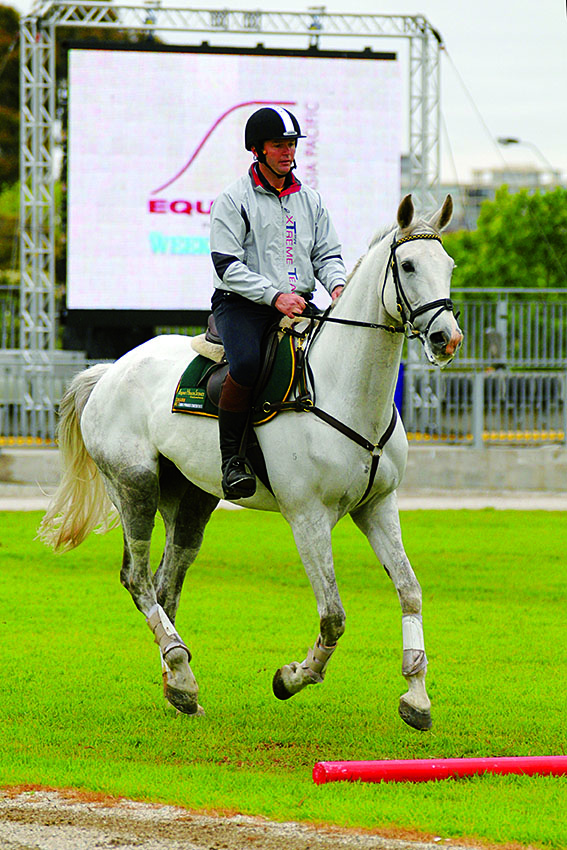
Good teaching, like good horse work, consists of doing very simple things very well, and the lesson that Clayton Fredericks put together for his class at Equitana was a perfect example of elegant simplicity in action. And what could be simpler than a few poles on the ground?
Well they certainly didn’t look that simple to Seamus Marwood’s Wild Oats, who was quite certain dragons lurked within, and just could not get the idea of quietly cantering over them.
As Clayton quipped, “This is every presenter’s nightmare. Am I brave enough to get on Seamus’ horse?”
Well he was, but there was certainly no magic instructor’s trick. Wild Oats continued to bounce up and down on the spot, even managing a little canter to the rear. Still Clayton was quick to highlight the lesson:
“This is a perfect opportunity to consider what training is all about. It’s not about stress, it’s not about pressure, it’s never losing your rag with a horse. My horse Ben Along Time has this clock in his head. After 40 minutes, he’s a nightmare to ride. With most of my horses, after 40 minutes, I put them back in the stable – I may bring them out later. With Ben, he usually has a huge pee in his stable and when I bring him out again, he’s fine.”
“I’m not going to complicate this exercise by forcing the horse into a shape, just let it learn from the exercise. Poles are great, they get horses thinking about what their feet are doing. We just give our horses poles, poles, and more poles. What you can do is only limited by your imagination.”
“At home, we’ll set up a whole course of poles on the floor. That way you can get control without having to jump a 1000 fences. We are working on one thing, getting the horse between leg and hand, and getting that control. All these exercises develop the horse’s canter, they give you the control to get the stride and be able to place the horse in a position to jump.”
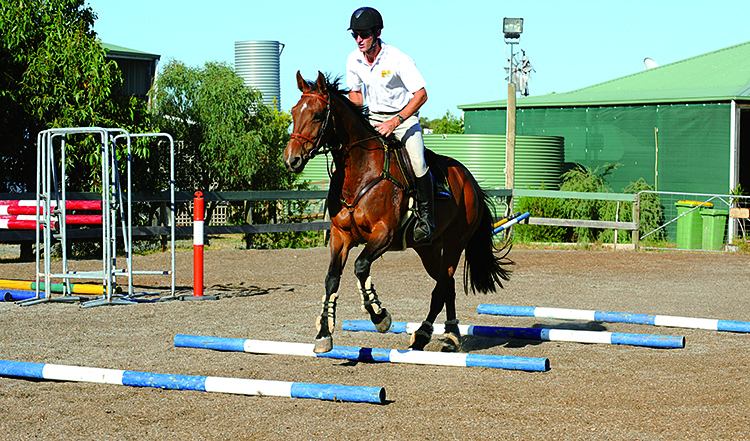
Seamus and Wild Oats back home and looking happier about poles
“To start with, with young horses sometimes you are battling just to get over the poles. You can get more sophisticated with a more advanced horse, try cantering down in shoulder in or in a travers. The dressage riders use lateral exercises all the time to improve their horses’ paces. We do the same but we incorporate poles and jumps. I do all these exercises in basically a dressage frame. I’m not leaving the saddle, I ride like I would on the flat.”
“Think about what you want to achieve. If you have a short striding horse, stretch the distances out. If your horse wants to run at fences, set the poles up on the short side to get them to slow up a bit. Gradually ask more, the bounces get bigger, ask the horse to round and bascule, and then you might need to ride more in a jumping position.”
“Another exercise is to ride this on a circle. It’s a similar theme, you don’t even need two poles to make the jump, you can start doing it with one, and again, it helps the rider see a stride. Young riders have problems placing their horse, and with our pupils, we use these exercises to get them going. Start with one fence, then two, then a circle.”
By now Seamus had moved on to a more educated mount, the grey Daley K son, War Wizard and was handling the exercise with ease, but Clayton is a demanding and perceptive teacher:
“The first thing I notice is that as he canters around the circle, the quarters drift to the outside. While you ride, think travers and improve the power of the hindleg. Every time he lands, try to put the quarters to the inside, wrap him round your inside leg.”
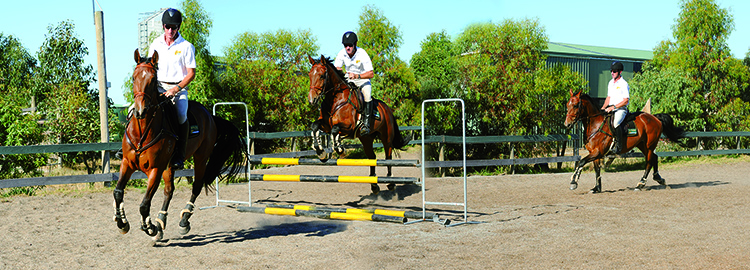
Wild Oats on the circle at home
“It’s important you have a very soft, even contact, with your elbow supremely elastic, you need to be soft in the elbow to follow with the hand. Now get him a little rounder in the frame, use the flexion exercises so they never lock and run. Use that soft elbow to position the horse’s poll, and the horse will never lock on your hand and run through the bit.”
“Every time you land, it’s important that you balance the horse in a straight way. Say you’ve got a horse that jumps through the right shoulder, try counter canter. Get him on the left lead on a right circle and counter flex him. It’s a fantastic exercise for horses that jump sideways. If he’s still leaning on the right shoulder, bend him to the right more. If he does a flying change, don’t worry about it – back to walk, back on the counter lead and repeat the exercise.”
Clayton then showed just how easy it is with very little equipment to train a young horse to jump skinny fences. Clayton sets up a chute of rails to lead the horse on to the skinny.
“Cross country today is less about big bold scary jumps, and more about accurate riding. When we start, we give the horse absolutely no opportunity to go anywhere except where we want them to go. It’s not about beating the horse and forcing it over a jump, it’s about slowly taking the time to get the horse’s confidence.”

“Don’t rush. Don’t set up the lane and then gallop down to the fence. We are looking for attitude from the horse, we want the horse to focus on the fence. When the horse starts to look at the fence, then put your leg on and pop over. Come in again and halt a little closer on a long rein. Let the horse look, and let the horse settle, let the horse lock on and see that the way out is over the skinny fence. But first we want to see the horse lower its body and look. And like everything, once you get it, repeat, repeat, repeat. It’s not about wrestling the horse over the jump, it’s the horse knowing where it has to go.”
“If you look at the photos of me through the water at the World Cup final that were in The Horse Magazine, you can see I’m up around Ben Along Time’s neck in the water, and he just looks between the flags and goes for it. Two strides out from the jump, he put his neck up and said ‘get back in the saddle Dad, I know what I am doing’ and he jumped it.”
“The horse has to take us. I don’t want half halts in front of the jump. Go on a long rein, let the horse lock on and know what the exercise is about. Whenever you interfere, you take their focus off the fence and it affects the jump. Be a bit braver with your horse – let it go and let it focus on the jump.”
And when the horse jumps it, Clayton is still not satisfied:
“He’s doing it now, but doing a little jump to the left. It’s vital that they are square in the shoulder when they jump, so I’ll put a pole on the landing to keep him straight.”
“It’s important at home to let the horse take you. If they want to run out, go back to the poles and the straightening exercise again. It’s all about letting the rein go, and the horse taking you to the centre. On a cross country fence if the horse wants to run sideways, then their focus goes off the fence and onto your hand, and then a disaster is about to happen.”
“One of the most common mistakes a rider can make, is to pull with the inside hand. Do that and they pop out the shoulder and all the energy runs away. Or the hindquarters swing out the other side. Using the inside rein is the worst thing; everything about the horse’s shoulders should be straight and square.”
And to show Seamus how to school this, he had him riding square corners on the grey.
“Keep the outside rein, and ride it like a pirouette – now complicate it – jump and turn to the skinny.”
Putting a series of fences together, Clayton had Wild Oats doing small circles in between the jumps:
“This is another exercise to help him. It also revolves around the aids for a pirouette. Jump and then when you land, go on a ten metre circle and when you feel that the horse is on the hindquarters, aim for the next jump. Open the inside rein, turn your body, if you want the horse’s shoulders in that direction, then you have to turn your shoulders in that direction, and sit in the middle. Outside rein / outside leg, get him on his hocks, keep him straight, maybe even a little counter bend. See how balanced the horse becomes. It is a great exercise to get the horse on its hocks, without popping out through the shoulder.”
It was time to show how to ride a little apex, and somehow Clayton had ‘acquired’ a handy jump made out of road barriers. “There’s nothing pompous about eventing riders, we’ll use anything we can to make jumps. Something lying on the road can be put together to make us a nice jump.”
“It’s getting harder to jump corners. The course designers are making the face of the jump narrower and narrower to increase the risk of a runout. Once we used to be told – dissect the jump, and jump across it. Now we train our horses to jump over a more angled face.”
Clayton kept increasing the angle of the arrowhead, and it was now getting very wide:
“Because we have been so systematic, the horse is happy to jump a 90 degree angle. Come on Seamus, you can jump this one.”
At this point Clayton confesses that he is enjoying putting a ‘selector under pressure’ but Seamus, who is the rider representive on the Eventing Selection Panel, can take a joke.
The next lesson is how to jump ditches:
“Some of you have seen the huge ditches with rails at the back, that we jump in eventing. How do we train them? You have to remember that eventers don’t have much money, we can’t build ditches even if we wanted to, and really I wouldn’t recommend schooling over big solid cross country fences. We very rarely go cross country training with our experienced horses – maybe once a year at the beginning of a season we’ll take them out to give them a splash in the water. We do take the young ones out cross country schooling because they have to get used to it.”
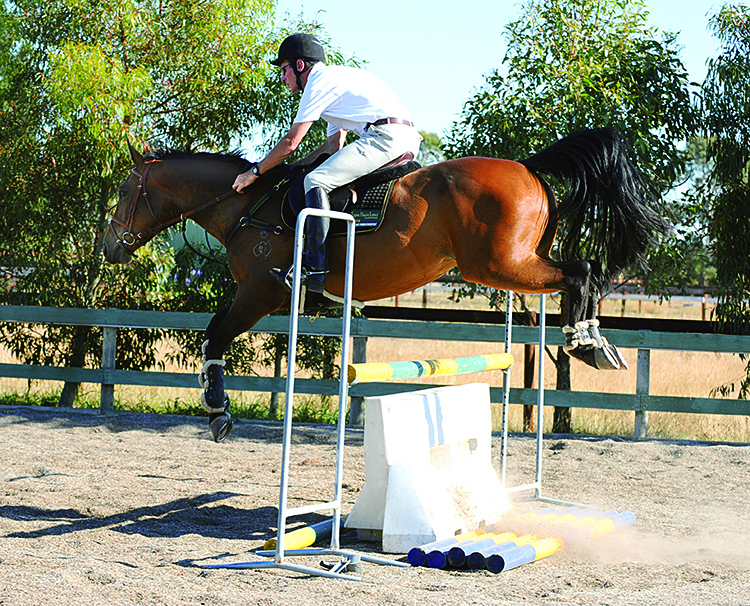
“All we need to build a ditch and rails is a heap of rails. When you are jumping a ditch and rails, you want to get the horse’s front feet as close to the ditch as possible. Just keep coming and keep the horse in front of your aids…”
And Clayton just kept adding more and more poles to make the jump more difficult for Seamus:
“That way when you arrive at an event and there is a ditch you can drive a Four Wheel Drive through, you don’t have to worry because you’ve trained this way at home.”
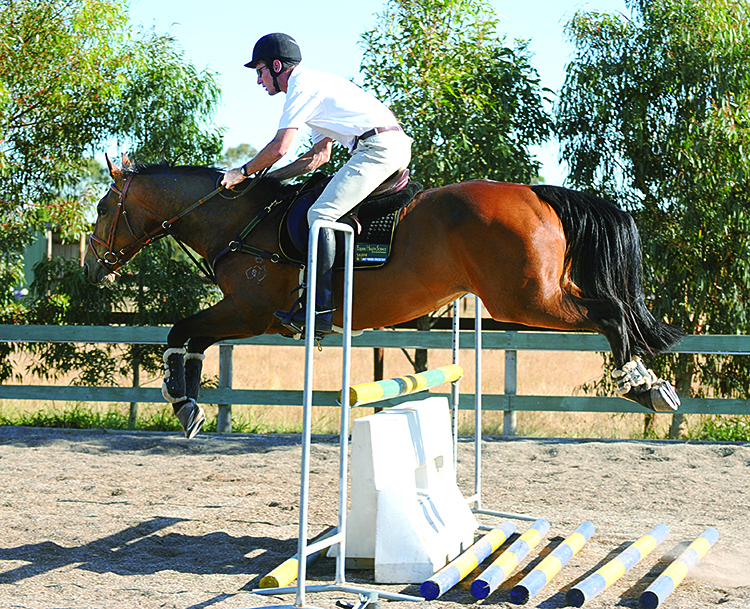
Clayton explained that in all the exercises he had demonstrated, the aim was to teach the rider the skill to place the horse.
“When we do these pole exercises it is vital to be able to place the horse. When you realise that you are not going to get to the spot, what do you do? That’s when you learn to shorten and lengthen. The best riders pick up jumps miles away. If you start trying to see what is happening two strides out, you have no chance of adjusting. If you are eight strides out, there’s two strides to see what is happening, and six in which to adjust. The earlier you look, the better the chance of getting a stride. Educating horses is about what happens between the fences – our work is half flat, half jumping, but we use the fences to get them to relax.”
“Lots of pole work and low fences are just as good at getting them careful as big tough fences – just keep the jumps close together. Sure they have to jump big fences every now and then to improve their scope, but as you can see, there is an awful lot you can do with a few poles and little showjumps.”

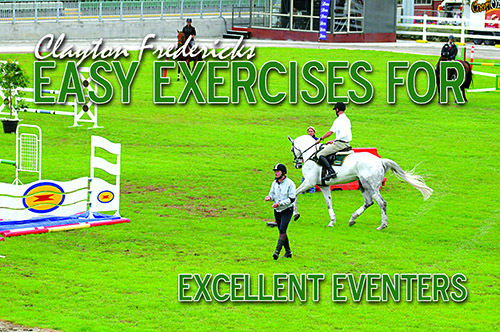
Good reading thank you!